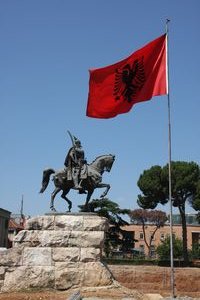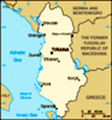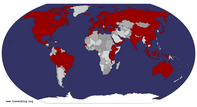Advertisement
Published: October 11th 2010

 Skanderbeg and Albanian flag
Skanderbeg and Albanian flag
The main square in central Tirana is named after Skanderbeg and this statue is in the middle of the squareMother Teresa, Enver Hoxha and George W Bush all in one blog entry
The last leg of our trip in the Balkans was Albania. To be honest we actually began this journey in Albania because that is where our initial flight went to. But we then only spent one day in Tirana before we continued to Sarajevo and Mostar in Bosnia and Herzegovina. So for us it is easier to write about this day in the Albanian capital here together with the rest of our stories from Albania.
Tirana is a quiet place. Parts of the town are slightly run down but it is not a bad place to visit. But there is very little there to see and to do so in one day we pretty much saw everything worth seeing in Tirana.
First we would like to mention a funny thing about Tirana that you won't see in the pictures. During the communist era in Albania the houses they built in the suburbs of Tirana were mainly dull concrete constructions very much looking like dull concrete constructions look everywhere, that is very very grey. When the Albanians gave up communism they also decided to give the

 Mother Theresa Square
Mother Theresa Square
Mother Teresa is a national icon in Albania and in Tirana there is a square named after hersuburbs a makeover. They painted the houses in all the colours of the rainbow. It helped and now the suburbs of Tirana look pretty nice actually. They even make some suburbs in Stockholm look dull and very very gray... Each time we saw these suburbs we were either in a bus or in a car and we never managed to get any photo of them.
Ask people what they know about Albania and most will have to admit they know very little. I can only think of two Albanian citizens that my friends have heard the name of and they are Mother Teresa and Enver Hoxha.
Mother Teresa doesn't really need any introduction but we'll make a very short one anyway. Or actually we steal it all from
the article on Wikipedia about her "Mother Teresa... , born Agnes Gonxha Bojaxhiu..., was a Catholic nun of Albanian ethnicity and Indian citizenship, who founded the Missionaries of Charity in Calcutta, India in 1950. For over 45 years she ministered to the poor, sick, orphaned, and dying, while guiding the Missionaries of Charity's expansion,.... Following her death she was beatified by Pope John Paul II and given the title Blessed Teresa of Calcutta.
....

 Emma gets a blessing from Mother Teresa
Emma gets a blessing from Mother Teresa
Is this sacreledge? If someone gets insulted we appologise but we just have to throw in a silly photo once in awhile
She won the Nobel Peace Prize in 1979 and India's highest civilian honour, the Bharat Ratna, in 1980 for her humanitarian work."
If you want to see a photo of Mother Teresa's grave you can do that on the blog entry Ake made when he
visited Kolkata in India. Mother Teresa is a national icon in Albania and in Tirana there is, among other things, a square in the city named after her.
Enver Hoxha was the leader of Albania from the 1940-ies to his death in 1985. When we were in Tirana Emma needed a rest in the afternoon. Then Ake, just to have something to do, decided to try to locate Enver Hoxha's grave. After a few tries he managed to make a taxi driver understand where he wanted to go and what he was looking for there. Since the taxi driver spoke no English and Ake speaks no Albanian the communication between the two was very limited. They did manage to agree on one thing though. The taxi driver's own words say it all: "Enver Hoxha. Dictatore".
Like so many other dictators in the world Enver Hoxha had a vision of himself of being revered by the

 The Pyramid
The Pyramid
Enver Hoxha had a pyramid built in central Tirana as a mausoleum and a museum over himselfpeople in his country. So he had a pyramid built in central Tirana for the sole purpose of being a mausoleum and to house an Enver Hoxha museum. The pyramid still stands there, one of the ugliest and most run down buildings in Tirana by the way, but with the communist era being over there of course is no museum over Enver Hoxha in it. In the guidebook it said that the house is used as a conference centre among other things.
To Albanians there is one Albanian who is just as famous as Mother Teresa and Enver Hoxha and that is
Skanderbeg, a warrior who liberated Albania from the Ottomans in the 15th century. The main square in central Tirana is named after Skanderbeg and on the square there is a statue of the man sitting on a horse.
When we returned to Albania after Montenegro we arrived in a city named Shkodra. The city Shkodra is of little interest other than as a transport hub. The only thing we saw when we visited Shkodra was a fortress outside town. It looked very much like fortresses do everywhere. It did give a nice view over the town

 Envers Hoxha's grave
Envers Hoxha's grave
The taxi driver's own words say it all: "Enver Hoxha. Dictatore"and the surroundings though.
We went to Shkodra in order to find transport to a village named Thethi. Thethi lies in a valley in a remote part of the Albanian mountains. Thethi has been a tourist destination for decades mainly for the beautiful nature. But there is one special attraction in the village that makes Thethi pretty unique - a lock-in tower.
In the 18th and 19th centuries there was a tradition of blood feuds in Albania. Blood feuds starts when a member of one family or clan inflicts some kind injustice on a member of another family or clan. Then the clan who suffered the injustice has to repay this by killing a member of the first clan. When they have done that the first clan in response to this kills someone from the second clan and so it goes back and forth sometimes for decades. Only young men took part in this blood feud business and only the young men risked getting killed by the rivalling clan. The blood feuds were surprisingly controlled and, in lack for a better word, civilised. This revenge and payback thing was so predictable that once one clan member from one

 George W Bush Street
George W Bush Street
A street in central Tirana is named after the former US president George W Bushfamily had been killed the men in that clan had nothing to fear anymore. There was never any "second killing for good measure" or "killing of the entire clan to make a final revenge". The rivalling clan, once they had done the killing they came for in the first place, simply withdrew to their own village and waited for the retiliation they knew was coming.
The interesting thing is that a clan always knew if they were in line to kill someone from the other clan or if they were in danger of getting killed. There was always one or the other and there was never any doubt which one of them. Here is where the lock-in towers come in. When the men of a clan had performed their grisly duty of killing someone from the rivalling clan they were turned from hunters to be hunted. The men then hurried back to their home and went into hiding in a lock-in tower. The lock-in tower is built so that there is clear view in all directions from the tower, making it impossible to ambush the people in the tower, and it is also strong enough to withstand bullets. In

 Fortress in Shkodra
Fortress in Shkodra
This is a small part of the fortress in Shkodrathese towers the men in the village could be forced to live for months. They were out of harms way but they probably had a pretty boring life. It was probably very much like being in prison. While the men were locked up in the lock-in tower the children, women and the elderly had to work the fields and they could not expect any help from the men in the village. So the rest of the clan, although not risking their lives, was also effected badly by this blood feud.
The blood feuds were abolished in the mid 20th century and most of the lock-in towers in Albania were dismantled. One of the few lock-in towers that still can be seen is the one in Thethi. It seems like the Albanians might have to erect new lock-in towers in the near future because in the last two decades some clans have once again started blood feuds.
After we left Thethi we went back to Tirana, rented a car there, and with this we embarked on a six day long journey in various parts of Albania.
The first stop we made after we left Tirana was the city

 View along the way to Thethi
View along the way to Thethi
Thethi lies in a valley in a remote part of the Albanian mountains and the views along the way are breathtakingDurresi on the Albanian coast. There main attraction for people to visit Durresi is the beaches. It was a hot day when we were there but the beaches was not where we were headed. We wanted to see some Roman ruins they have unearthed there. There are ruins after a bathhouse, a forum and a large amphitheatre. The amphitheatre has an interesting history to it. It was built in the second century and was continuously used for its original purpose for many years until one day when the city was struck by a devastating earthquake. The earthquake damaged the amphitheatre so badly that it couldn't be repaired and it was abandoned. Later parts of the ruins were used as a church and they also used the area as a graveyard. Eventually the old Roman amphitheatre was all forgotten about and the locals started to build houses on the spot. One day in the 1960-ies the ground under one of the houses collapsed creating a hole and parts of the house went down into this hole. This was completely unexpected since everybody thought that the house was built on solid ground. When they started digging to find the reason for the

 Sheep along the way to Thethi
Sheep along the way to Thethi
Some of the traffic on the way to Thethi had four wheels, some had four legscollapse they found the amphitheatre. Still today there are some houses remaining on top of the ruins so parts of the amphitheatre has yet not been excavated. But the parts that have been unearthed are impressive enough to be worth a visit.
When we were in Durresi we also went for a walk down to the beachfront. There we saw a fortified tower dating back to the 16th century. The tower was erected during a period when Durresi was part of the Republic of Venice, a nation that existed in this part of southern Europe from the 8th century until the end of the 18th century.
After Durresi we drove to a town called Berati. Berati has a picturesque old town and on a hill towering over the town there is a fortress. Inside the fortress there are houses and there are people living there. So strictly, it is more appropriate to call the upper part of Berati a fortified town rather than a fortress. The funny thing about this fortified section of the town is that while it is a tourist attraction where they charge an entrance fee making tourists walk around thinking that it is a

 Thethi valley
Thethi valley
Thethi has been a tourist destination for decades mainly for the beautiful naturemuseum at the same time people call it their home and actually live there. It's not a unique situation but unusual.
By the way, we never managed find out why there is a street in central Tirana named George W Bush street.
Advertisement
Tot: 0.11s; Tpl: 0.018s; cc: 14; qc: 31; dbt: 0.0468s; 1; m:domysql w:travelblog (10.17.0.13); sld: 1;
; mem: 1.2mb
































Maria Tingdahl
non-member comment
Long time, no see
I notice some things have changed since I was in Tirana and Shkodra.. back in May '92. Spent the major part of that month in Shkodra. I've climbed the small fortress too. There was a man scratching some white sediment of some kind from the rocks that built the main gate for his breastfeeding wife for her to get more milk for her baby (calcium perhaps??). There were also stories about people that had tried to escape the communist regime by smearing their whole bodies with butter and trying to swim under water, just breathing above water, across the nearby lake (can't remember its name) into former Yugoslavia (Montenegro, I assume). There were also "mushrooms" in clusters of 2-4 together of small limed concrete bunkers scattered over the countryside, for people to take shelter in when the outside world was to attack Albania as they were "world leaders" in every aspect, according to Hoxha. Suppose their all broken down or piles of rubble these days.. Thanx, brings many memories back - I haven't been back since!